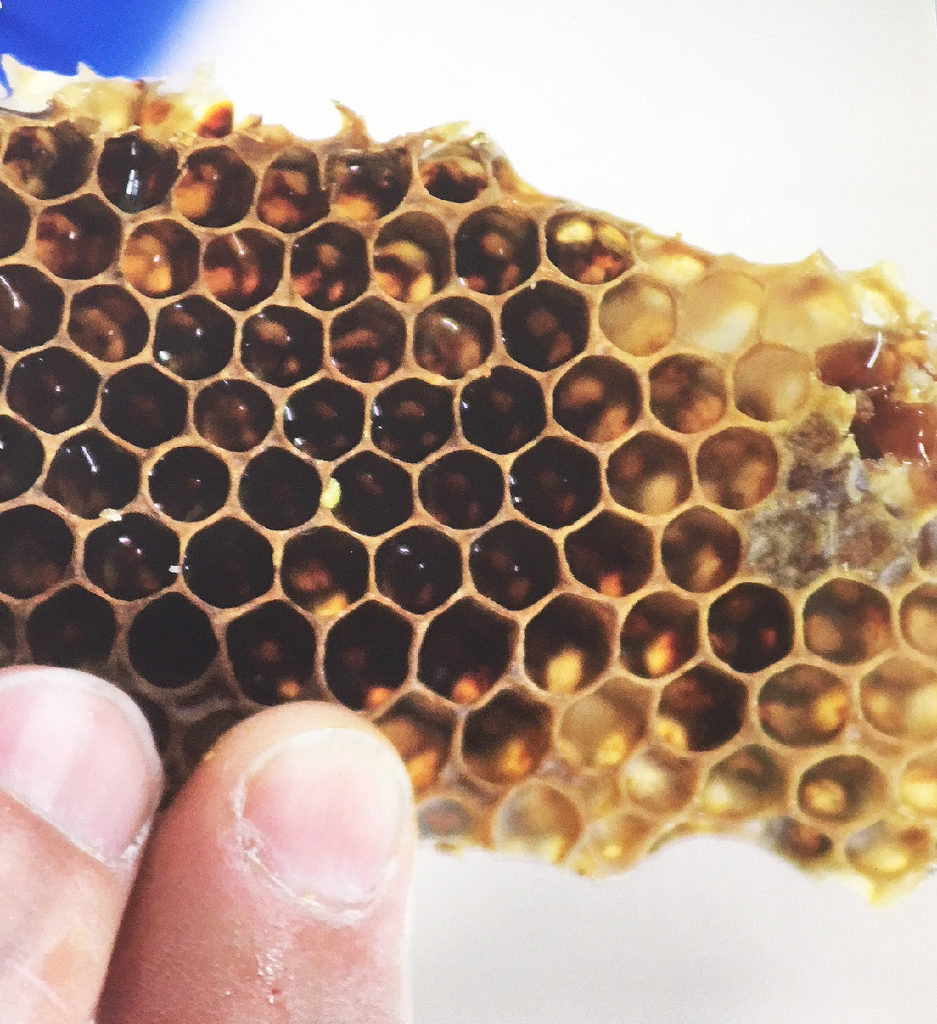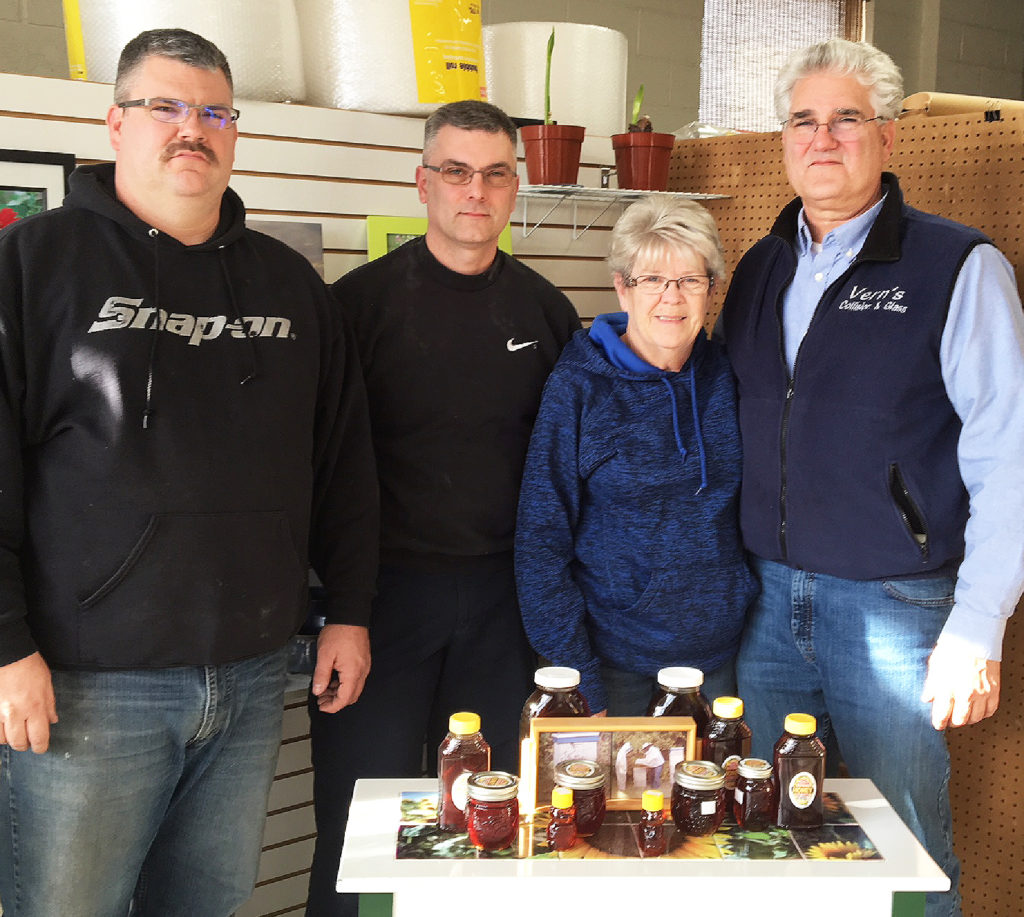By Patsy Isenberg
Flint’s East Side may be a tattered symbol to some human eyes of the city’s struggles. But it turns out honeybees like it just fine.
The wildflowers sprouting up in abandoned lots and brownfields may be the secret ingredient that makes city honey sweet – better even than rural honey, according to an East Side family of beekeepers who say they have become fascinated by bees and are doing their best to try to save the buzzy pollinators.
Local businessman Mike Herriman and his family – wife, Trudy; sons, Aaron and Jerin; and sometimes reluctant grandchildren – are beekeepers, or as Trudy calls them, hive keepers. Herriman also owns and operates an auto shop, Vern’s Collision, on Davison Road.
As if that isn’t enough to keep him busy, he’s also a very active volunteer for the College Cultural Neighborhood Association (CCNA), chairing the Neighborhood Watch group.

East Side honeycomb (photo by H&H Farms)
But it’s the bees and the honey that brought EVM to visit him recently after an editor saw the honey for sale at the collision shop and was curious to get the lowdown on what it takes to make honey in the city and why East Side honey, according to Herriman, sometimes tastes of cinnamon.
It was actually Trudy and Aaron who began the venture several years ago. Trudy, a master gardener and pottery student at the Flint Institute of Arts (FIA), kept hearing about beekeeping and a “Bees 101” class at For-Mar Nature Preserve and Arboretum in Burton. Out of curiosity the two of them took the course.
“I heard so much about it at Master Gardener, and For-Mar had a Bees 101 class so I said, ‘Aaron, you want to go to that?’ He said ‘yeah’ so we sat there mesmerized for three hours,” Trudy explained. “And I said (to the teacher) ‘when’s the next class?’ and he said, ‘nobody’s ever asked me that before.’ “
They did take the next class and continued to be mesmerized. After that, Aaron decided to invest in some hives and learned more about bees and honey. The rest of the family got hooked as well. They started out with 14 hives, which arrived in three-pound shoe-box-sized containers of about 30,000 bees each. Over time, they’ve started producing and labeling small batches of sweetness under the name H & H Pure Michigan Wild Flower Honey.
While Aaron is a font of information on the subject of bees and honey, the family often calls on Darren Bagley from the Michigan State University Extension for guidance whenever they have questions.
Aaron placed the first hives on Jerin’s six-acre property outside of town, but soon found that they get better honey in the city. Honey varies in color and pollen content depending on when and where you collect it, he explained.

East Side hive keepers (from left) Jerin, Aaron, Trudy and Mike Herriman (Photo by Patsy Isenberg)
One main thing to consider is what kinds of flora are available for the bees to eat and then produce honey. Wildflower honey is what will be produced by bees in cities and that is what the Herrimans wanted. They say honey from urban areas is better that rural honey because of the lack of insecticides typically sprayed in rural areas for farming.
There currently is demand for another type of honey as well. Buckwheat honey is popular with some people and the Herrimans tried placing some of their hives in a buckwheat field. According to Trudy, the honey was remarkably different than the wildflower honey in the city. “It’s grittier. It has a coarse texture to it and I don’t care for it, but some people just absolutely love it,” she said.
Their beekeeping has evolved over the years to include monitoring and controlling what the bees are eating to a certain degree. According to the Herrimans, the bees eat whatever is currently in bloom and the honey varies from collection to collection, both in flavor and color.
Some people have commented that the current batch tastes of cinnamon and is a medium, amber color. “Normally the lighter color the honey is the sweeter it is. The darker is more robust,” Aaron explained. They don’t know how to explain the hints of cinnamon.
There are potential profits to be made with honey production. “A hive can produce 100 pounds of honey and even at a wholesale price of $3 a pound, a honey producer sees that they can get $600 from a full hive. If they have 200 hives, that’s a good profit,” Aaron said.
“And when you consider that a box of bees costs $150… money wise it makes more sense to utilize the entire hive for honey production…but you’re watering down the genetics of the bees,” he added.
But it’s about more than just the honey or profits to the Herrimans.
“We got into it to help save the bees,” Trudy said. “The honey is just sort of an aftereffect. There’s some hive keepers in it for the honey…and they don’t really care if the bees live through the year or not.”
In fact, they keep some details of their operation secret, because, the Herrimans say, there is such a thing as bee hive theft. They requested that no photos made the locations recognizable.
According to an National Public Radio (NPR) report from January, 2017, “the Fish and Wildlife Service gave endangered status to seven species of yellow-faced bees native to Hawaii, the first time any U.S. bees received this kind of protection” in October of 2016. They also reported that for the first time, a bumblebee was placed on the endangered species list in January, 2017.
“Pollinator decline is a global trend. A recent major global assessment sponsored by the U.N. suggested that about 40 percent of invertebrate pollinator species are facing extinction. Since some 75 percent of food crops rely at least partially on pollinators, that raises serious concerns about the future of the global food supply,” NPR reported.
Because of this, the Herrimans attempt to be as ecologically smart as possible when it comes to collecting their honey. For instance, the hives they use have drawers of different sizes with artificial combs already built. The lower drawers are larger, hold twice as much honey, and, if not tampered with, serve as a home for the bees. The Herrimans leave those larger drawers at the bottom alone to keep the bees undisturbed. Honey producers who are just in it for the money don’t do that.
For the bees Trudy keeps in her backyard, she uses a different type of hive, called a bar hive. The bees make their own combs on a hive of this type. The hives the bees make look as perfect as the artificial ones used in the drawer types–perfect hexagonal holes. Both the manufactured combs and the ones the bees make have holes that are on a downwards slant so that the honey doesn’t run out if it becomes thin, like on a hot day. But she says the bar hives won’t produce collected honey easily.
Unlike many local honey producers, the Herrimans don’t filter their honey. They strain it two times and spin the honey out of the combs in a machine. One benefit of unfiltered honey is help with pollen-related allergies.
Aaron explained, “It’s almost like a vaccination” against those particular allergens that a person lives around, which makes local honey desirable. On the subject of allergies, when asked about allergies to bee stings Aaron said that “Everybody is one sting away from being allergic. You can get stung 1,000 times and the 1001th you become allergic. So, you never know.”
Asked where the very best honey comes from the answer came quickly. Trudy said, “the East Side” and Mike responded, “The closest to where you live.”
Though they’re not in beekeeping for the money, the Herrimans do have some regular customers for their honey. A restaurant called Grandma’s Recipes on Richfield Road uses the Herriman’s brand of honey from H & H Farms. Asked if they ever thought of selling it at the Farmer’s Market, they said they don’t produce enough to keep up with the likely demand at an outlet like that.
More information about H & H Pure Michigan Wild Flower Honey is available at 810-423-2360.
EVM Staff Writer Patsy Isenberg can be reached at pisenber@gmail.com.


You must be logged in to post a comment.